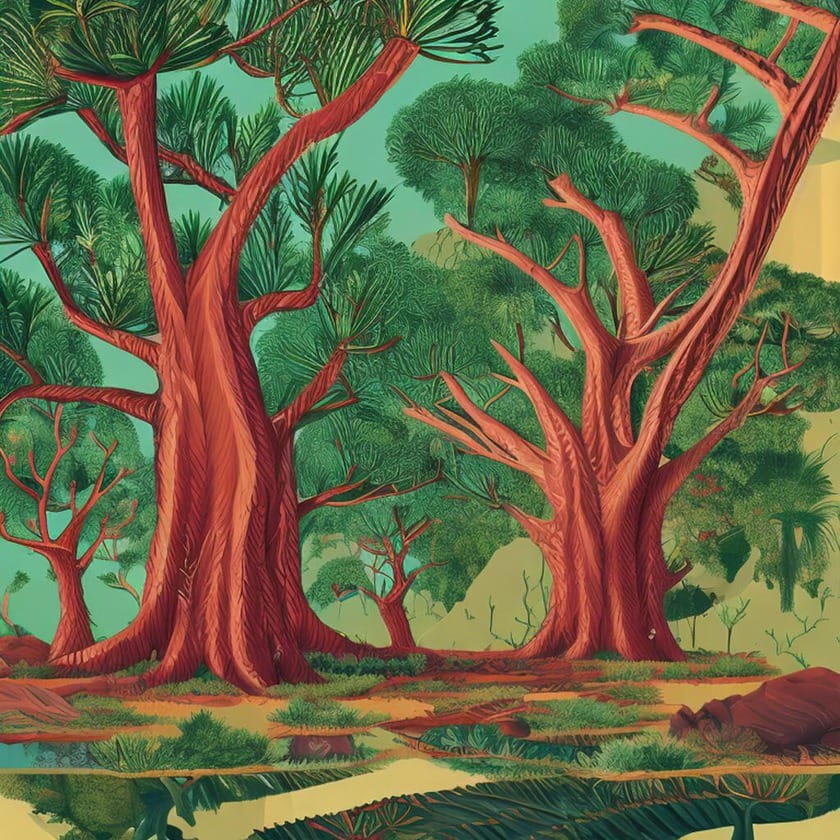Sacred trees in Australia
Sacred trees have played a significant role in Australian Aboriginal culture for thousands of years. They are often seen as physical representations of the spiritual world and are the focus of many rituals and ceremonies.
In many Aboriginal cultures, trees are believed to be the homes of spirits or ancestors. People may offer food, drink, or other offerings to these spirits as a way of seeking their blessings or protection. Trees are also used as places of worship, and people may gather under the shade of a sacred tree to pray, sing, or perform other religious ceremonies.
In addition to their spiritual significance, sacred trees have played an important role in the practical lives of Aboriginal people. The bark, leaves, and other parts of some trees are used in traditional medicines, and some trees are used to build homes, tools, and other important items.
Some of the most famous sacred trees in Australia are the giant baobab trees of the Kimberley region in Western Australia. These trees are believed to be over 1,000 years old and are the subject of many Aboriginal creation myths.
Unfortunately, many of Australia’s sacred trees are at risk due to deforestation, climate change, and other environmental threats. This has led to efforts to protect and preserve these trees, both for their cultural significance and for their ecological value.
Efforts to protect sacred trees in Australia include the establishment of nature reserves, the promotion of sustainable forestry practices, and the education of local communities about the importance of preserving their cultural heritage. By working together to protect these trees, we can ensure that they continue to play an important role in Australian Aboriginal culture for generations to come.
Examples of sacred trees in Australia and their significance
Boab trees (Adansonia gregorii)
Boab trees, scientifically known as Adansonia gregorii, are iconic and revered trees found in the Kimberley region of Western Australia. These remarkable trees hold a sacred status among Aboriginal people, deeply woven into their cultural and spiritual life. Boab trees are often used as places of worship and are integral to creation myths and stories that have been passed down through generations. The unique, bottle-shaped trunks of these ancient trees are not only striking in appearance but also serve as living monuments to the rich oral traditions of Aboriginal cultures.
In addition to their spiritual significance, Boab trees are highly valued for their medicinal properties. The bark and leaves of the Boab tree have been traditionally used to treat a variety of ailments, including infections, fevers, and digestive issues. Aboriginal healers prepare remedies from the Boab tree’s parts to harness its natural healing potential, reflecting a deep knowledge of the local flora and its benefits.
The connection between Boab trees and Aboriginal people is also evident in the landscape, where these trees often mark significant cultural sites. They stand as symbols of resilience and continuity, embodying the enduring relationship between the land and its original inhabitants. Despite the pressures of modern development, efforts to protect and preserve Boab trees and their cultural heritage are crucial.
Recognizing the importance of Boab trees can help foster greater respect and understanding for Aboriginal traditions and the ecological knowledge embedded within them. Conservation initiatives should aim to protect these sacred trees, ensuring they continue to thrive and support both the biodiversity of the Kimberley region and the cultural practices of its people. By safeguarding Boab trees, we honor the deep spiritual connections and ecological wisdom of Aboriginal cultures.
River red gum trees (Eucalyptus camaldulensis)
River red gum trees, scientifically known as Eucalyptus camaldulensis, are majestic and widespread trees found throughout Australia. These trees hold a deep spiritual and cultural significance for many Aboriginal communities, who consider them sacred. River red gum trees often serve as vital meeting places where people gather for social, cultural, and ceremonial activities. They are intricately linked to the Dreaming, the creation period in Aboriginal mythology, which encompasses the spiritual beliefs and ancestral stories that shape the world and its landscapes.
The towering presence of river red gum trees along rivers and floodplains symbolizes resilience and continuity, echoing the timeless narratives of the Dreaming. These trees not only provide a physical space for community gatherings but also embody the connection between Aboriginal people and the land. The shade and shelter offered by their expansive canopies create natural venues for storytelling, teaching, and cultural transmission.
Beyond their spiritual and cultural roles, river red gum trees are highly valued for their wood. The durable and versatile timber of these trees is traditionally used to craft a variety of tools and weapons, such as boomerangs, spears, and shields. This utilization of river red gum wood highlights the resourcefulness and deep ecological knowledge of Aboriginal communities, who have sustainably managed and utilized these trees for generations.
Conservation of river red gum trees is crucial not only for preserving biodiversity but also for maintaining the cultural heritage of Aboriginal peoples. Protecting these sacred trees ensures that future generations can continue to connect with their ancestral stories and practices. Recognizing and respecting the cultural significance of river red gum trees fosters a deeper appreciation for the rich traditions and ecological wisdom of Australia’s Aboriginal communities, reinforcing the vital link between nature and culture.
Ghost gum trees (Corymbia aparrerinja)
Ghost gum trees, scientifically known as Corymbia aparrerinja, are striking and revered trees found in the Northern Territory of Australia. These ethereal trees, with their smooth, white bark and graceful appearance, hold a sacred place in the culture of the Arrernte people. Deeply intertwined with the Dreaming, the ghost gum tree is seen as a powerful symbol of the connection between the spiritual and physical worlds. The Dreaming encompasses the foundational stories and beliefs of the Arrernte people, detailing the creation of the land, its features, and its inhabitants.
The ghost gum’s presence in the rugged landscape of the Northern Territory serves as a reminder of the enduring spiritual heritage of the Arrernte people. These trees often mark significant cultural sites and are central to various ceremonial practices. Their distinctive white trunks, especially when illuminated by moonlight, evoke a sense of mystery and reverence, further enhancing their spiritual significance.
In addition to their sacred role, ghost gum trees are valued for their practical uses. The wood of the ghost gum tree is prized for its strength and versatility, making it an excellent material for crafting traditional tools and weapons. Items such as spears, shields, and digging sticks are often fashioned from ghost gum wood, reflecting the resourcefulness and deep ecological knowledge of the Arrernte people.
Conserving ghost gum trees is essential for preserving the cultural and spiritual heritage of the Arrernte community. Efforts to protect these trees help maintain the biodiversity of the Northern Territory and ensure that the spiritual connections embodied by the ghost gums endure for future generations. By safeguarding ghost gum trees, we honor the profound relationship between the Arrernte people and their land, celebrating the rich tapestry of stories and traditions that these majestic trees represent.
Wollemi pine trees (Wollemia nobilis)
Wollemi pine trees, scientifically known as Wollemia nobilis, are extraordinary and rare botanical wonders found in a secluded region of New South Wales, Australia. Discovered in 1994, these ancient trees are considered one of the most significant plant discoveries of the last century, often referred to as “living fossils” due to their lineage dating back millions of years to the time of the dinosaurs. Their remarkable history and unique appearance have captivated the scientific community and the public alike.
For some Aboriginal communities, the Wollemi pine holds a sacred status, deeply connected to ancient spiritual practices and cultural heritage. These trees are seen as symbols of resilience and continuity, embodying the enduring presence of life through vast spans of geological time. The sacredness of the Wollemi pine is reflected in its incorporation into various spiritual rituals and practices that honor the profound relationship between the land and its original custodians.
Beyond their spiritual significance, Wollemi pines are also valued for their potential medicinal properties. Researchers are exploring the biochemical compounds found in these trees, which may offer new insights and applications in medicine. The conservation of Wollemi pine trees is paramount, given their rarity and the small number of individuals remaining in the wild. Efforts to protect and propagate these trees are ongoing, involving both in-situ and ex-situ conservation strategies to ensure their survival.
The story of the Wollemi pine is one of discovery, reverence, and scientific intrigue. By safeguarding these unique trees, we not only preserve a crucial link to our planet’s distant past but also respect the cultural and spiritual values they hold for Aboriginal communities. The Wollemi pine stands as a testament to the richness of Australia’s natural heritage and the importance of conserving its unique and ancient flora for future generations.
Sacred trees in Australia are often associated with creation myths and stories, the Dreaming, and the spiritual world. They are valued for their spiritual significance, their medicinal properties, and their use in traditional tools and weapons. By preserving and protecting these trees, we can help ensure that they continue to play an important role in Australian Aboriginal culture for generations to come.
Shop tip
Boab trees (Adansonia gregorii) on Amazon
River red gum trees (Eucalyptus camaldulensis) on Amazon
Ghost gum trees (Corymbia aparrerinja) on Amazon
Wollemi pine trees (Wollemia nobilis) on Amazon
Sacred trees in Australia on Amazon

Thank you for likes, shares and comments! 🌳🌴🌲🌵
Source OpenAI’s chatGPT Language Models, Dalle, AI trot and Fleeky
images Picsart and MIB
Invest in your future
Take time to learn
Embark on your journey in affiliate marketing and website creation alongside an incredible community and myself. Invest in your future by dedicating time to learn and earn. Take all the time you need to master the basics before aiming higher. Give it a try and sign up for free. You won't regret it! Discover the possibilities for yourself...


